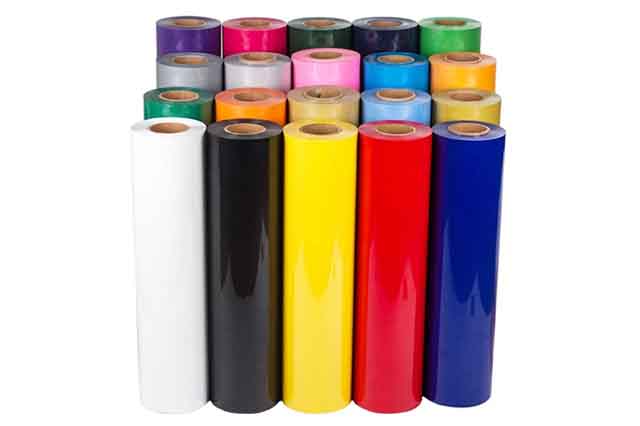In the article we will examine the different types of HTV that exist and we will refer to the differences between the different types and their effect on choosing the right vinyl.

There are several types of heat transfer vinyl (HTV), each with their own unique properties and characteristics. Some of the most common types include:
– Polyurethane (PU) HTV:
This type of HTV is known for its durability and resistance to stretching and fading. It is a popular choice for sportswear and outdoor gear.
– Polyvinyl chloride (PVC) HTV:
This type of HTV is known for its flexibility and ease of cutting. It is a popular choice for intricate designs and lettering.
– Glitter HTV:
This type of HTV is a variant of PVC HTV and contains glitter particles that give a metallic or sparkling look. It is often used for special occasion wear, such as holiday or prom shirts.
– Flock HTV:
This type of HTV has a velvet-like texture. It is often used to create a raised or 3D effect on designs.
– Metallic HTV:
This type of HTV has a metallic finish, which can give a reflective look. It is popular for special occasions and events, and it is often used to make logos and emblems.
– Glow in the dark HTV:
This type of HTV has a phosphorescent finish which glows in the dark after being exposed to light. it is often used for creative projects, party clothes or even for safety vests.
– Blocking HTV:
this type of HTV is designed for printing on dark synthetic fabrics where there may be migration of the fabric color to the print color.
These are just a few examples of HTV, but there are many other variations and speciality HTV in the market. It is important to choose the right type of HTV for the specific application, considering the material it will be applied on and the desired final look of the design.
What are the differences between the types of heat-printed vinyl?
Besides the color of course, there are other things to consider when choosing the type of vinyl:
– flexibility:
Some vinyls have higher tensile strength than others. This is especially important in sportswear or printing on stretchy fabrics.
– Washing resistance:
Different types of heat transfer vinyl have different resistance to washing. Most vinyls are resistant to washing up to 40 degrees Celsius, but there are types that are also resistant to 60 and 80 degrees. This matter is of great importance if the shirts are intended to undergo multiple washings (for example shirts for workers).
– Vinyl thickness:
Different types of vinyl have different thicknesses. The thickness is measured in microns and ranges from 30 microns to 130 microns. The thicker the vinyl, the more noticeable it will be on the fabric. Conversely, low thickness vinyl will be more flexible and stretchable.
– Layers:
There are types of vinyl that can be attached in layers – the meaning is that vinyl can be glued on top of another vinyl. This makes it possible to create colorful graphics on the shirt.
– Cutting pressure:
Each vinyl has a different cutting pressure that needs to be set on the cutting plotter in order to get a clean cut of the vinyl and result in easy peeling.
– Cutting angle:
Each vinyl has the setting for the angle of the cutting blade. According to this definition, we need to choose the knife we will use in the cutting plotter.
– Peeling:
The vinyl comes in two layers – the vinyl itself and a transparent polyester film used to carry the vinyl. After heat gluing, peel off the carrier film. There are two settings for peeling – hot peeling, which means that the carrier can be removed immediately after the shirt leaves the heat press, and cold peeling, which means that you have to wait until the print cools down to remove the carrier.
– Sticky carrier or not:
There are two types of carrier tape for vinyl – adhesive and non-adhesive. The sticky carrier holds the vinyl in a stronger way and allows more precise cutting for small details. On the other hand, this means that it is more difficult to peel off the excess vinyl after cutting. A non-sticky carrier allows easier peeling but makes it difficult to cut small details and is therefore mainly used for printing large and uniform graphics (player number for example).
Summary
It is important to remember: each HTV supplier has the detailed settings for the use of his vinyl, so it is important to read the printing instructions and familiarize yourself with them before ordering the HTV. It is also important to know what the requirements of the graphic are – for example, whether it has small details or not, because this will help to choose the right type of vinyl and will affect the duration of the work.
